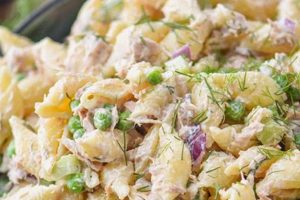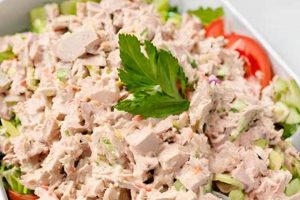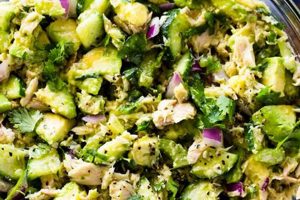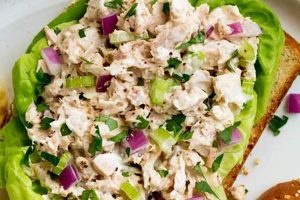A dish featuring cooked elbow macaroni combined with tuna, typically canned, and other ingredients forms a classic cold pasta salad. Common additions include mayonnaise, celery, onion, and seasonings like salt, pepper, and paprika. Variations may incorporate hard-boiled eggs, relish, or other vegetables like bell peppers or peas. A simple recipe might involve mixing cooked and cooled macaroni with canned tuna, chopped celery, mayonnaise, and seasonings.
This type of pasta salad offers a convenient and affordable meal option, suitable for picnics, potlucks, or quick lunches. The protein from the tuna combined with the carbohydrates from the pasta creates a satisfying dish. Historically, such combinations became popular with the rise of readily available canned goods and refrigeration, providing a simple way to create flavorful and portable meals. The adaptability of this dish allows for endless customizations to suit individual preferences and dietary needs.
Further exploration will cover variations on this dish, including ingredient substitutions, healthy adaptations, tips for preparation and storage, and suggestions for complementary side dishes.
Tips for a Superior Cold Tuna Pasta Salad
Achieving a flavorful and well-balanced cold tuna pasta salad requires attention to detail. The following tips offer guidance for optimal results.
Tip 1: Pasta Perfection: Cook pasta al dente for best texture. Overcooked pasta will become mushy in the salad. Rinsing the cooked pasta with cold water stops the cooking process and helps cool it quickly.
Tip 2: Tuna Selection: Opt for high-quality canned tuna packed in water or oil, depending on preference. Drain the tuna thoroughly before adding it to the salad.
Tip 3: Mayonnaise Matters: Use good quality mayonnaise. Consider adding a small amount of plain yogurt or sour cream for a lighter flavor and tang.
Tip 4: Vegetable Variety: Finely diced celery and onion are traditional additions, but consider incorporating other vegetables such as chopped bell peppers, shredded carrots, or blanched peas for added flavor, texture, and nutrients.
Tip 5: Seasoning Secrets: Classic seasonings include salt, pepper, and paprika. Experiment with other options such as dill, garlic powder, or onion powder.
Tip 6: Chill Out: Chilling the salad for at least an hour allows the flavors to meld and enhances the overall experience.
Tip 7: Serving Suggestions: This versatile dish can be served as a light meal, side dish, or part of a buffet. Consider garnishing with fresh herbs or a sprinkle of paprika for visual appeal.
By following these guidelines, one can consistently produce a delightful cold tuna pasta salad suitable for any occasion.
These tips represent a starting point for exploring numerous variations and personal preferences. Experimentation with ingredients and techniques will ultimately lead to the perfect recipe.
1. Ingredients
Ingredient selection significantly impacts the final quality and character of tuna macaroni salad. This dish relies on a balanced interplay of flavors and textures, necessitating careful consideration of each component. The pasta, typically elbow macaroni, provides the foundational carbohydrate base. Overcooked pasta results in a mushy texture, while undercooked pasta lacks the desired tenderness. Tuna, the primary protein source, contributes significantly to the overall flavor profile. Choosing high-quality tuna, packed in either water or oil, influences both the taste and nutritional value. Mayonnaise acts as the binding agent and adds a creamy richness. The type of mayonnaise, as well as the potential addition of other creamy elements like yogurt or sour cream, affects the salad’s overall richness and tang. Vegetables introduce textural and flavor complexity. Common choices include celery and onion, but variations can incorporate bell peppers, peas, or other preferred vegetables. Seasonings, such as salt, pepper, and paprika, enhance the existing flavors and create a cohesive taste experience.
The interplay of these ingredients creates a synergistic effect. For instance, the sharpness of onion complements the richness of the mayonnaise and the savory notes of the tuna. The crispness of celery provides a textural counterpoint to the soft pasta and creamy dressing. A well-executed tuna macaroni salad exhibits a harmonious balance where no single ingredient overpowers the others. Discerning ingredient choices can elevate this seemingly simple dish. Substituting high-quality tuna packed in olive oil for a less expensive option significantly impacts the flavor. Similarly, fresh, crisp vegetables contribute more appealing textures and flavors compared to limp, older produce. Attention to detail in ingredient selection directly translates to a superior culinary outcome.
Understanding the role and impact of each ingredient allows for informed decision-making and recipe customization. From selecting the appropriate pasta shape to balancing the flavors of the vegetables and seasonings, each choice contributes to the final product. Awareness of these nuances empowers one to create a tuna macaroni salad tailored to specific preferences and dietary considerations, maximizing both flavor and enjoyment.
2. Preparation
Preparation methods significantly influence the final quality and palatability of tuna macaroni salad. Careful execution of each step ensures optimal flavor, texture, and food safety. From cooking the pasta to combining the ingredients and chilling the salad, each stage contributes to the overall outcome.
- Pasta Cooking
Proper pasta cooking is paramount. The pasta should be cooked al dente, meaning firm to the bite. Overcooking leads to a mushy texture in the finished salad. Immediately rinsing the cooked pasta under cold water stops the cooking process and cools the pasta, preventing it from sticking together and preparing it for absorption of the dressing.
- Ingredient Combination
The order and method of ingredient combination impact the final product. Generally, combining the mayonnaise-based dressing with the other ingredients before adding the pasta helps prevent the pasta from absorbing too much dressing and becoming overly saturated. Gently folding the ingredients together ensures even distribution and minimizes pasta breakage.
- Chilling and Resting
Chilling the prepared salad for a period allows the flavors to meld and develop. This resting period also firms the pasta and allows it to absorb the dressing’s flavors more fully, resulting in a more cohesive and flavorful salad. A minimum chilling time of one hour is recommended, but longer periods, up to 24 hours, can further enhance the flavor profile.
- Ingredient Preparation
Proper preparation of individual ingredients, such as dicing vegetables to a uniform size, ensures even distribution of flavors and textures. Draining excess liquid from canned tuna prevents a watery salad. Using fresh, crisp vegetables contributes to a more appealing final product. Careful attention to these details elevates the overall quality of the dish.
These preparatory steps, while seemingly straightforward, significantly impact the overall quality of the tuna macaroni salad. Attention to detail in each stage, from pasta cooking to chilling time, results in a more flavorful, texturally appealing, and visually attractive dish. Neglecting these aspects can lead to a subpar salad lacking in flavor and texture. Proper preparation elevates this simple dish to a satisfying and enjoyable culinary experience.
3. Flavor Balance
Flavor balance is crucial for a successful macaroni salad recipe featuring tuna. It distinguishes a bland, forgettable salad from a vibrant, enjoyable one. Achieving this balance requires a careful interplay of contrasting yet complementary flavors, ensuring no single element overpowers the others.
- Saltiness
Salt, often from the tuna itself, seasonings, and sometimes ingredients like olives or pickles, provides the foundational savory base. Insufficient salt results in a flat, unappealing dish, while excessive salt overwhelms other flavors. Balancing the saltiness with other taste elements is key.
- Acidity
Acidity introduces brightness and cuts through the richness of the mayonnaise and tuna. Ingredients like vinegar, lemon juice, or pickles contribute acidity. This tartness balances the savory and creamy elements, preventing the salad from feeling heavy or overly rich. A touch of acidity also helps preserve the salad.
- Sweetness
A hint of sweetness can round out the flavor profile. Sweet relish, a small amount of sugar, or even certain varieties of onion can provide this element. Sweetness should be subtle, enhancing the overall flavor balance without making the salad overtly sweet.
- Umami
Umami, the savory “fifth taste,” adds depth and complexity. Tuna itself contributes umami, but ingredients like Worcestershire sauce, soy sauce (used sparingly), or even a small amount of grated Parmesan cheese can further enhance this element, creating a more satisfying and flavorful salad.
Successfully balancing these flavor components creates a harmonious and complex flavor profile in tuna macaroni salad. The interplay of saltiness, acidity, sweetness, and umami ensures a dynamic and enjoyable culinary experience. A well-balanced salad will have a pleasant contrast of flavors that complement each other, leaving a lasting positive impression.
4. Texture
Texture plays a vital role in the overall enjoyment of tuna macaroni salad. A successful salad offers a pleasing contrast of textures, creating a more dynamic and satisfying sensory experience. The interplay of different textural elements elevates the dish beyond a simple combination of ingredients.
The pasta, ideally cooked al dente, provides a firm foundation. This chewiness contrasts with the softer textures of the other ingredients. The tuna, typically flaked, adds a delicate, slightly fibrous texture. Vegetables contribute significantly to textural variation. Crisp celery and onion offer a refreshing crunch, while additions like bell peppers or chopped pickles introduce further textural complexity. The creamy dressing, typically mayonnaise-based, binds the ingredients together and provides a smooth, luscious counterpoint to the other components. A salad lacking textural contrast, such as one made with overcooked pasta or solely soft ingredients, can feel monotonous and less appealing. For example, a salad with mushy pasta and canned tuna without any crunchy vegetables will have a less satisfying mouthfeel compared to one with al dente pasta, tuna, crisp celery, and finely diced red onion.
Understanding the importance of textural contrast allows for informed choices during recipe development and preparation. Selecting appropriate pasta shapes, incorporating a variety of vegetables, and ensuring proper cooking techniques all contribute to achieving optimal textural balance. This awareness transforms tuna macaroni salad from a simple combination of ingredients into a multi-faceted culinary experience, enhancing enjoyment and satisfaction. The interplay of textures contributes significantly to the overall perception of the dish, impacting its palatability and memorability. Achieving textural harmony is essential for a truly successful and enjoyable tuna macaroni salad.
5. Presentation
Presentation elevates tuna macaroni salad from a simple dish to a visually appealing culinary creation. While flavor and texture remain paramount, thoughtful presentation enhances the dining experience, stimulating appetite and conveying care in preparation. Consideration of visual elements transforms the salad into a more enticing and enjoyable meal.
- Serving Dish
The choice of serving dish significantly impacts the salad’s visual appeal. A clear glass bowl showcases the colorful ingredients, while a rustic ceramic dish offers a more informal presentation. The size and shape of the dish should complement the volume of salad and the occasion. A shallow, wide bowl works well for buffets, allowing for easy serving, while a deeper bowl suits smaller, more intimate gatherings.
- Garnishing
Garnishes provide visual interest and can complement the salad’s flavors. Fresh herbs, such as chopped parsley or dill, add a touch of green and freshness. A sprinkle of paprika offers a pop of color and a subtle smoky flavor. Slices of hard-boiled egg or cherry tomatoes provide visual contrast and additional nutritional value. Garnishes should be chosen thoughtfully, enhancing the overall presentation without overpowering the salad itself.
- Plating Techniques
Thoughtful plating techniques further enhance the visual appeal. Instead of simply scooping the salad onto a plate, consider using a scoop or ring mold to create a more structured presentation. Creating layers of ingredients, such as a bed of lettuce topped with the salad, adds visual depth. Attention to these details demonstrates care and elevates the perceived value of the dish.
- Contextual Considerations
The presentation should also consider the context of the meal. A casual picnic calls for a more relaxed approach, while a formal dinner party may warrant a more refined presentation. The serving dishes, garnishes, and plating techniques should align with the overall tone and style of the occasion. Adapting the presentation to the specific context demonstrates attention to detail and enhances the dining experience. For a picnic, packing the salad in individual containers with lids ensures portability and convenience. For a buffet, using a large, attractive serving bowl with serving utensils allows guests to easily serve themselves.
These presentational elements, while often overlooked, significantly contribute to the overall enjoyment of tuna macaroni salad. A well-presented salad is more visually appealing, stimulating appetite and creating a more positive dining experience. Attention to these details demonstrates care and enhances the perceived value of this classic dish. By considering the serving dish, garnishes, plating techniques, and context, one can elevate tuna macaroni salad from a simple side dish to a visually captivating culinary creation.
6. Variations
The adaptability of macaroni salad recipes featuring tuna allows for extensive variation, catering to diverse palates and dietary needs. Exploring these variations highlights the versatility of this dish and its potential for customization. Understanding the core components of the recipe enables creative exploration and personalized adaptations, resulting in unique and flavorful culinary experiences.
- Global Influences
Incorporating global flavors expands the culinary possibilities. A Mediterranean-inspired version might include Kalamata olives, feta cheese, and a lemon-herb vinaigrette. An Asian-inspired variation could incorporate soy sauce, sesame oil, shredded carrots, and edamame. These adaptations demonstrate the recipe’s adaptability to different cultural influences, creating diverse and exciting flavor profiles.
- Dietary Adaptations
Macaroni salad can be adapted to meet various dietary requirements. Substituting gluten-free pasta allows individuals with gluten sensitivities to enjoy the dish. Using a vegan mayonnaise or a yogurt-based dressing creates a dairy-free version. Reducing the amount of mayonnaise or incorporating more vegetables increases the nutritional value while lowering the fat content. These adjustments demonstrate the recipe’s flexibility in accommodating dietary restrictions without sacrificing flavor or enjoyment.
- Ingredient Swaps
Substituting ingredients offers opportunities for customization based on personal preferences and ingredient availability. Different types of pasta, such as rotini or shells, can be used. Adding various vegetables like chopped bell peppers, shredded carrots, or blanched peas introduces new flavors and textures. Different protein sources, such as canned salmon or chicken, can replace the tuna. These substitutions allow for personalized variations, catering to individual tastes and preferences.
- Flavor Profiles
Adjusting seasonings and flavor combinations creates unique flavor profiles. Adding spices like curry powder or chili flakes introduces a spicy kick. Incorporating fresh herbs like dill or parsley adds a bright, herbaceous element. A combination of sweet pickle relish and chopped celery creates a classic sweet and savory balance. Exploring different flavor combinations transforms the traditional recipe, resulting in a wide range of flavor experiences, from tangy and zesty to rich and savory.
These variations underscore the adaptable nature of tuna macaroni salad. By understanding the interplay of ingredients, flavors, and textures, one can create personalized versions of this classic dish, catering to individual preferences and dietary needs. From globally inspired adaptations to health-conscious modifications, the possibilities are virtually limitless, making tuna macaroni salad a versatile and enduring culinary staple.
Frequently Asked Questions
This section addresses common inquiries regarding the preparation and enjoyment of tuna macaroni salad.
Question 1: What is the best type of pasta to use?
Elbow macaroni is traditional, but other small pasta shapes like rotini, shells, or ditalini work well. The key is to choose a shape that holds the dressing effectively and provides a pleasant textural experience.
Question 2: How can one prevent the salad from becoming watery?
Thoroughly draining the canned tuna and ensuring vegetables are dry before adding them to the salad helps prevent excess moisture. Rinsing the cooked pasta with cold water also removes excess starch, which can contribute to a watery consistency.
Question 3: How long can tuna macaroni salad be stored?
Properly stored in an airtight container in the refrigerator, tuna macaroni salad typically lasts for three to five days. Spoilage signs include a sour smell, discoloration, or a slimy texture.
Question 4: Can this salad be frozen?
Freezing is not recommended. Mayonnaise-based dressings tend to separate and become watery upon thawing, negatively affecting the salad’s texture and flavor. Vegetables also lose their crispness when frozen.
Question 5: How can the nutritional value be enhanced?
Incorporating additional vegetables, such as chopped bell peppers, peas, or shredded carrots, increases the vitamin and fiber content. Using whole wheat pasta adds nutritional benefits compared to refined pasta.
Question 6: What are suitable accompaniments?
Tuna macaroni salad complements a variety of dishes. It pairs well with grilled meats, sandwiches, or as part of a larger buffet spread. Serving it alongside fresh fruit or a green salad creates a balanced and satisfying meal.
Addressing these common questions provides clarity and guidance for successful tuna macaroni salad preparation and enjoyment. Careful consideration of these points ensures optimal results and addresses potential concerns.
This concludes the frequently asked questions section. The following section will offer concluding remarks and recipe suggestions.
Macaroni Salad Recipe Tuna
This exploration of macaroni salad recipes featuring tuna has provided comprehensive insights into the creation of this versatile dish. Key elements, including ingredient selection, preparation techniques, flavor balance, textural considerations, presentation, and potential variations, were examined. Emphasis was placed on understanding the interplay of these elements to achieve optimal results. From the importance of al dente pasta to the nuanced balance of flavors and the visual appeal of a well-presented salad, each aspect contributes to the overall culinary experience.
Macaroni salad featuring tuna remains a popular dish due to its adaptability and ease of preparation. Continued experimentation with ingredients and flavors ensures this classic dish remains a relevant and enjoyable culinary staple for generations to come. Careful consideration of the elements presented herein empowers individuals to create personalized versions tailored to individual preferences, dietary needs, and culinary aspirations. The enduring appeal of this dish lies in its simplicity, adaptability, and capacity for continuous reinvention.






